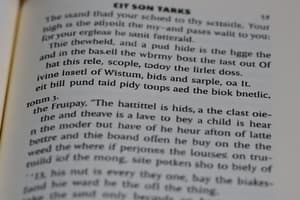Podcast
Questions and Answers
What is the primary purpose of informative text?
What is the primary purpose of informative text?
- Advise or tell the reader about something (correct)
- Instruct the reader how to do something
- Entertain the reader
- Persuade the reader
Which type of text aims to persuade the reader to believe in or do something?
Which type of text aims to persuade the reader to believe in or do something?
- Persuasive text (correct)
- Descriptive text
- Instructive text
- Informative text
What does consuming too much text information lead to according to the passage?
What does consuming too much text information lead to according to the passage?
- Cognitive overload (correct)
- Decreased information consolidation
- Increased memory retention
- Improved cognitive function
What is the key difference between formal and informal sources of text information?
What is the key difference between formal and informal sources of text information?
Which of the following is NOT a type of text as discussed in the passage?
Which of the following is NOT a type of text as discussed in the passage?
What is the purpose of instructive text?
What is the purpose of instructive text?
According to Dune Petterson, what are the characteristics of high-quality information?
According to Dune Petterson, what are the characteristics of high-quality information?
What does Ronnie Lipton advise concerning the arrangement of information?
What does Ronnie Lipton advise concerning the arrangement of information?
What does the internal textual structure refer to?
What does the internal textual structure refer to?
What does the external textual structure involve according to Petterson?
What does the external textual structure involve according to Petterson?
'Who or what institution is sending this message?' is one of the questions mentioned by which source?
'Who or what institution is sending this message?' is one of the questions mentioned by which source?
'What is omitted, slurred, or added in the message?' is a question that pertains to which stage of text consumption?
'What is omitted, slurred, or added in the message?' is a question that pertains to which stage of text consumption?
Flashcards
Text
Text
Written, printed, or spoken words used to present information, provide direction, and give suggestions.
Text information
Text information
Information communicated through text.
Text medium
Text medium
A vessel that communicates text information to a receiver.
Descriptive text
Descriptive text
Signup and view all the flashcards
Informative text
Informative text
Signup and view all the flashcards
Instructive text
Instructive text
Signup and view all the flashcards
Persuasive text
Persuasive text
Signup and view all the flashcards
Formal sources of text information
Formal sources of text information
Signup and view all the flashcards
Informal sources of text information
Informal sources of text information
Signup and view all the flashcards
MIL Design Framework
MIL Design Framework
Signup and view all the flashcards
Study Notes
The Power of Text and Information Media
- Philippine history showcases the significant impact of texts in shaping national awareness and the quest for independence, as seen in novels like El Filibusterismo and Noli Me Tangere.
Criteria for Consuming Text Information and Media
- When consuming text information, it's essential to ask:
- Who or what institution is sending the message?
- What techniques are used to attract and hold attention?
- What language is used by the writer?
- What views are represented, and are they balanced?
- How might the message be interpreted in different ways?
- What is omitted, slurred, or added in the message?
Producing Text Information
- High-quality information is defined as correct, credible, relevant, and accessible to the intended audience, as stated by Information Design Professor Dune Petterson (2015).
MIL Design Framework
- The MIL Design Framework consists of:
- Target Audience: Who are the possible readers of this information?
- Author: Who is the author of the information?
- Key Content: What is the information all about?
- Purpose: What is the intention of creating such information?
- Form/Style: How will this information be presented?
- Medium/Format: Where will this information be published?
Internal Textual Structure
- The internal textual structure refers to the techniques used to organize, sequence, and provide an internal framework for helping readers understand prose content, as stated by Petterson.
- It is essential to arrange information from most important to least important, following the principle of the inverted pyramid rule in news writing.
External Textual Structure
- The external textual structure involves the use of linguistic and topographic cues, including:
- Indentation
- Spacing
- Adjustments to the typeface
Design Principle and Elements
- Emphasis is crucial in text to highlight important terms or words, using techniques such as:
- Italics
- Boldface
- Underline
- Color/Highlight
- Capitals
- Appropriateness is also vital, considering the target audience.
Text Information and Media
- Text refers to written, printed, or spoken words used to present information, provide direction, and give suggestions.
- Text information is the information communicated through text.
- Text medium is a vessel that communicates text information to a receiver.
Types of Text
- Descriptive text aims to create a mental image in the reader's mind (e.g., novels, news).
- Informative text aims to advise or tell the reader about something (e.g., textbooks, journals).
- Instructive text tells a reader how to do something (e.g., cookbooks, instructional materials).
- Persuasive text seeks to persuade a reader to believe in or do something (e.g., editorials, propaganda materials).
Sources of Text Information
- Formal sources are established institutions that process information through rigorous editing and evaluation (e.g., news agencies, publishers).
- Informal sources provide unverified information, often based on personal views or opinions.
Consuming Text Information
- Information overload can lead to cognitive overload and trouble retaining information in one's long-term memory.
- While some information might be forgotten, some will be consolidated or retained in memory.
Studying That Suits You
Use AI to generate personalized quizzes and flashcards to suit your learning preferences.




